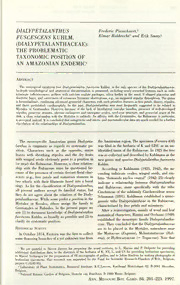
Dialypetalanthus Fuscescens Kuhlm. (Dialypetalanthaceae): The Problematic Taxonomic Position of an Amazonian Endemic PDF
Preview Dialypetalanthus Fuscescens Kuhlm. (Dialypetalanthaceae): The Problematic Taxonomic Position of an Amazonian Endemic
DIALYPETALANTHUS FUSCESCENS KUHLM. (DIALYPETALANTHACEAE): THE PROBLEMATIC TAXONOMIC OF POSITION AN AMAZONIAN ENDEMIC 1 Volume Number 2 84, Piesschaert 203 et al. 1997 Dialypetalanthus fuscescens from Amazonia The wood scope. In order show the thickenings of the inner fluted toward the base. is light but ex- to used house construc- tangential walls of the exotestal cells, the outer tan- tremely hard. It is locally for & we gential walls had be removed. Therefore, boiled tion (Rizzini Occhioni, 1949), but as far as to know economic seeds were transferred to a 3:1 mixture of alcohol it has little value. 96% 99% and 24 Afterward acetic acid for hours. The 3% Leaves. simple leaves are decussately ar- they were put a aqueous mixture of sulphuric in The ranged and have blades with entire margins. from acid 50°C 10 hours (modified at for at least cm) and petiole well developed (0.6-3.5 shallow- Braune Remaining specks of were is et 1967). dirt al., The sulcate above. blades are broadly elliptic ly removed by ultrasonication. suborbiculate The methods used and breaking (L/W-ratio 1.5:1), elliptic (2:1), (1.2: for acetolysis by Huysmans to narrowly (2:1) or widely obovate (1.2:1) pollen grains are discussed in detail 1), (sometimes asymmetric), with a shortly acu- Wood were slightly anatomical sections pre- et al. (1994). pared as described by Jansen et (in prep.). al. neate slighdy decurrent base (terminology follow- to X ing Hickey, 1988); they are (2-)6-17(-20) (1-) Results 4—11(— cm. The leaf venation pinnate and 14) is VEGETATIVE STRUCTURES camptodromous. Hie veins, especially the midvein 1A), are prominent on the abaxial side of the Habit. Dialypetalanthus fuscescens is a large, (Fig. The divergence angle between primary and blade. 35° (because of secondary veins is about in the center of the usually has a fibrous smaller). soft, It phellogen blade and gradually rises toward the base of the the formation of several concentric lay- The up The trunk veins are detectable to the order. red cinnamon-colored bark. is leaf. fifth ers), to la in size (upper ones much larger than the short, tain silica-bodies (Fig. 4G, H). The perforation tri- angular lower ones; Fig. Anatomically, the stip- plates of the vessels are simple, bearing a single 2). ules have a characteristic adaxial epidermis, con- elliptical to almost circular opening (Fig. 5A). The The sisting of thickened Scattered through the vessel-ray pits are simple (Fig. 5B). intervessel cells. homogeneous chlorenchyma are numerous small pits are alternately arranged and vestured (Fig. 5C). phloem vascular traces that are surrounded by fibers. Riz- Internal is absent. and zini Occhioni (1949) recorded occasioned par- REPRODUCTIVE STRUCTURES acytic The bloom Wood, anatomy. The wood of Dialypetalanthus Inflorescence. of Dialypetalanthus is shows indistinct growth rings (probably reflecting The the precipitation cycle), marked by a transition large inflorescences. inflorescence of Dialype- Kuhlmann from thin- to thick-walled fibers. The fibers are sep- talanthus (Figs. 6-8) was described by tate (Fig. 4C) and have simple pits in vertical rows (1925) as paniculate and racemose. Rizzini and Oc- (Fig. 5D) (libriform fibers sensu Baas, 1986). The chioni (1949) and Hutchinson (1959) also indicated wood diffuse-porous. The vessels are solitary or was a panicle. According to Weberling (1992), a is it by on arranged in short radial rows (2-8 cells) (Fig. 4D, panicle is characterized terminal flowers its E). In young wood, close to the pith, the radial main axis and side branches. Thus, a panicle is a how- The determinate inflorescence. Dialypetalanthus, vessel rows are often longer. outline of the sol- itary vessels rounded 4E), although the ever, does not have a terminal flower but a terminal (Fig. is may smaller vessels are often compressed between the bud that at first sight be confused with a single bud larger ones. Axial parenchyma present and oc- terminal flower. Dissection of the terminal re- is The meristem where acropetal inception curs as scanty, paratracheal strands (Fig. 4B). veals a floral width of the rays varies from (l-)2 to 6 cells (Fig. of lateral flowers occurs (the flowers in the most 4A); may exceed 100 In radial terminal zone seem to be poorly developed) (Fig. their height cells. The have inflorescence of Dialypetalanthus thus sections, the procumbent body-ray cells a 7). is margin of one or often several layers of square cells indeterminate, contrary to a panicle. Dahlgren and Thome (Fig. 4F). Sometimes a mixture of procumbent and (1984) provided the first correct illustration more or less square cells occurs. The rays are vis- of the inflorescence but did not describe it. Cron- was ible to the naked eye as clear, narrow, parallel quist (1981) the first to correctly call the Di- a More lines. The pith and the rays contain very small cu- alypetalanthus inflorescence thyrse. specif- occur a frondobracteose, heterothetic, bic to prismatic crystals; navicular crystals ically, it is as well. The septate fibers as well as the rays con- indeterminate thyrse with opposite branches (Fig. 206 Annals the of Garden Missouri Botanical !? i lilUM !iH«»ii! Garden Volume Number 2 84, Piesschaert 209 et al. 1997
